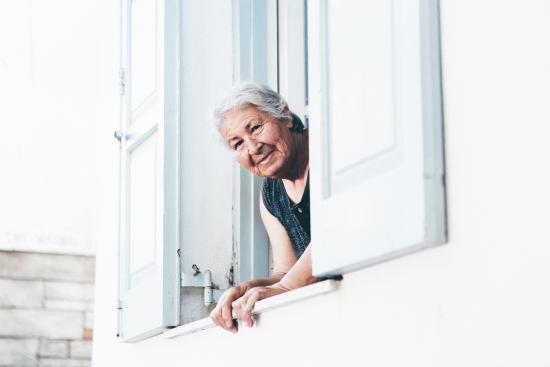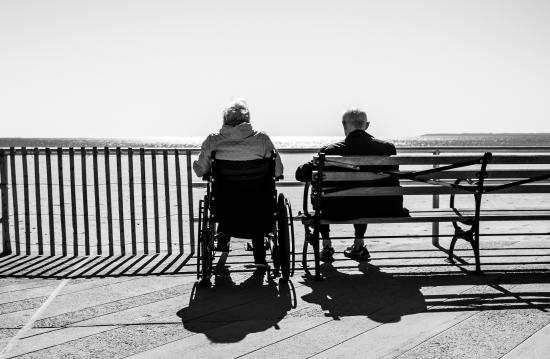10.2: Late Adulthood
- Page ID
- 69425
\( \newcommand{\vecs}[1]{\overset { \scriptstyle \rightharpoonup} {\mathbf{#1}} } \)
\( \newcommand{\vecd}[1]{\overset{-\!-\!\rightharpoonup}{\vphantom{a}\smash {#1}}} \)
\( \newcommand{\dsum}{\displaystyle\sum\limits} \)
\( \newcommand{\dint}{\displaystyle\int\limits} \)
\( \newcommand{\dlim}{\displaystyle\lim\limits} \)
\( \newcommand{\id}{\mathrm{id}}\) \( \newcommand{\Span}{\mathrm{span}}\)
( \newcommand{\kernel}{\mathrm{null}\,}\) \( \newcommand{\range}{\mathrm{range}\,}\)
\( \newcommand{\RealPart}{\mathrm{Re}}\) \( \newcommand{\ImaginaryPart}{\mathrm{Im}}\)
\( \newcommand{\Argument}{\mathrm{Arg}}\) \( \newcommand{\norm}[1]{\| #1 \|}\)
\( \newcommand{\inner}[2]{\langle #1, #2 \rangle}\)
\( \newcommand{\Span}{\mathrm{span}}\)
\( \newcommand{\id}{\mathrm{id}}\)
\( \newcommand{\Span}{\mathrm{span}}\)
\( \newcommand{\kernel}{\mathrm{null}\,}\)
\( \newcommand{\range}{\mathrm{range}\,}\)
\( \newcommand{\RealPart}{\mathrm{Re}}\)
\( \newcommand{\ImaginaryPart}{\mathrm{Im}}\)
\( \newcommand{\Argument}{\mathrm{Arg}}\)
\( \newcommand{\norm}[1]{\| #1 \|}\)
\( \newcommand{\inner}[2]{\langle #1, #2 \rangle}\)
\( \newcommand{\Span}{\mathrm{span}}\) \( \newcommand{\AA}{\unicode[.8,0]{x212B}}\)
\( \newcommand{\vectorA}[1]{\vec{#1}} % arrow\)
\( \newcommand{\vectorAt}[1]{\vec{\text{#1}}} % arrow\)
\( \newcommand{\vectorB}[1]{\overset { \scriptstyle \rightharpoonup} {\mathbf{#1}} } \)
\( \newcommand{\vectorC}[1]{\textbf{#1}} \)
\( \newcommand{\vectorD}[1]{\overrightarrow{#1}} \)
\( \newcommand{\vectorDt}[1]{\overrightarrow{\text{#1}}} \)
\( \newcommand{\vectE}[1]{\overset{-\!-\!\rightharpoonup}{\vphantom{a}\smash{\mathbf {#1}}}} \)
\( \newcommand{\vecs}[1]{\overset { \scriptstyle \rightharpoonup} {\mathbf{#1}} } \)
\( \newcommand{\vecd}[1]{\overset{-\!-\!\rightharpoonup}{\vphantom{a}\smash {#1}}} \)
\(\newcommand{\avec}{\mathbf a}\) \(\newcommand{\bvec}{\mathbf b}\) \(\newcommand{\cvec}{\mathbf c}\) \(\newcommand{\dvec}{\mathbf d}\) \(\newcommand{\dtil}{\widetilde{\mathbf d}}\) \(\newcommand{\evec}{\mathbf e}\) \(\newcommand{\fvec}{\mathbf f}\) \(\newcommand{\nvec}{\mathbf n}\) \(\newcommand{\pvec}{\mathbf p}\) \(\newcommand{\qvec}{\mathbf q}\) \(\newcommand{\svec}{\mathbf s}\) \(\newcommand{\tvec}{\mathbf t}\) \(\newcommand{\uvec}{\mathbf u}\) \(\newcommand{\vvec}{\mathbf v}\) \(\newcommand{\wvec}{\mathbf w}\) \(\newcommand{\xvec}{\mathbf x}\) \(\newcommand{\yvec}{\mathbf y}\) \(\newcommand{\zvec}{\mathbf z}\) \(\newcommand{\rvec}{\mathbf r}\) \(\newcommand{\mvec}{\mathbf m}\) \(\newcommand{\zerovec}{\mathbf 0}\) \(\newcommand{\onevec}{\mathbf 1}\) \(\newcommand{\real}{\mathbb R}\) \(\newcommand{\twovec}[2]{\left[\begin{array}{r}#1 \\ #2 \end{array}\right]}\) \(\newcommand{\ctwovec}[2]{\left[\begin{array}{c}#1 \\ #2 \end{array}\right]}\) \(\newcommand{\threevec}[3]{\left[\begin{array}{r}#1 \\ #2 \\ #3 \end{array}\right]}\) \(\newcommand{\cthreevec}[3]{\left[\begin{array}{c}#1 \\ #2 \\ #3 \end{array}\right]}\) \(\newcommand{\fourvec}[4]{\left[\begin{array}{r}#1 \\ #2 \\ #3 \\ #4 \end{array}\right]}\) \(\newcommand{\cfourvec}[4]{\left[\begin{array}{c}#1 \\ #2 \\ #3 \\ #4 \end{array}\right]}\) \(\newcommand{\fivevec}[5]{\left[\begin{array}{r}#1 \\ #2 \\ #3 \\ #4 \\ #5 \\ \end{array}\right]}\) \(\newcommand{\cfivevec}[5]{\left[\begin{array}{c}#1 \\ #2 \\ #3 \\ #4 \\ #5 \\ \end{array}\right]}\) \(\newcommand{\mattwo}[4]{\left[\begin{array}{rr}#1 \amp #2 \\ #3 \amp #4 \\ \end{array}\right]}\) \(\newcommand{\laspan}[1]{\text{Span}\{#1\}}\) \(\newcommand{\bcal}{\cal B}\) \(\newcommand{\ccal}{\cal C}\) \(\newcommand{\scal}{\cal S}\) \(\newcommand{\wcal}{\cal W}\) \(\newcommand{\ecal}{\cal E}\) \(\newcommand{\coords}[2]{\left\{#1\right\}_{#2}}\) \(\newcommand{\gray}[1]{\color{gray}{#1}}\) \(\newcommand{\lgray}[1]{\color{lightgray}{#1}}\) \(\newcommand{\rank}{\operatorname{rank}}\) \(\newcommand{\row}{\text{Row}}\) \(\newcommand{\col}{\text{Col}}\) \(\renewcommand{\row}{\text{Row}}\) \(\newcommand{\nul}{\text{Nul}}\) \(\newcommand{\var}{\text{Var}}\) \(\newcommand{\corr}{\text{corr}}\) \(\newcommand{\len}[1]{\left|#1\right|}\) \(\newcommand{\bbar}{\overline{\bvec}}\) \(\newcommand{\bhat}{\widehat{\bvec}}\) \(\newcommand{\bperp}{\bvec^\perp}\) \(\newcommand{\xhat}{\widehat{\xvec}}\) \(\newcommand{\vhat}{\widehat{\vvec}}\) \(\newcommand{\uhat}{\widehat{\uvec}}\) \(\newcommand{\what}{\widehat{\wvec}}\) \(\newcommand{\Sighat}{\widehat{\Sigma}}\) \(\newcommand{\lt}{<}\) \(\newcommand{\gt}{>}\) \(\newcommand{\amp}{&}\) \(\definecolor{fillinmathshade}{gray}{0.9}\)Ageism and Abuse
Ageism
How do Stereotypes Effect Older Adults?
![Five sets of road signs, the top one green and the bottom one red in each set, are shown along the right-hand side of a road in a desert setting. The green signs all read “Senior Center” and feature an arrow pointing left. The blue signs, from front to back, read “Don’t Forget,” “Remember to [u]Turn![/u]”, “Wake Up!”, “Lunch Only $4,” and “Turn Now.”](https://oercommons.s3.amazonaws.com/media/courseware/openstax/m52956/Figure_13_03_02.jpg) Figure 10.2.3: Are these street signs humorous or harmful? (Flickr license: Tumbleweed via Flickr)
Figure 10.2.3: Are these street signs humorous or harmful? (Flickr license: Tumbleweed via Flickr)In many modern nations, however, industrialization contributed to the diminished social standing of the elderly. Today wealth, power, and prestige are also held by those in younger age brackets. The average age of corporate executives was fifty-nine years old in 1980. In 2008, the average age had lowered to fifty-four years old (Stuart 2008). Some older members of the workforce felt threatened by this trend and grew concerned that younger employees in higher level positions would push them out of the job market. Rapid advancements in technology and media have required new skill sets that older members of the workforce are less likely to have.
Changes happened not only in the workplace but also at home. In agrarian societies, a married couple cared for their aging parents. The oldest members of the family contributed to the household by doing chores, cooking, and helping with child care. As economies shifted from agrarian to industrial, younger generations moved to cities to work in factories. The elderly began to be seen as an expensive burden. They did not have the strength and stamina to work outside the home. What began during industrialization, a trend toward older people living apart from their grown children, has become commonplace.
Mistreatment and Abuse
Mistreatment and abuse of the elderly is a major social problem. As expected, with the biology of aging, the elderly sometimes become physically frail. This frailty renders them dependent on others for care—sometimes for small needs like household tasks, and sometimes for assistance with basic functions like eating and toileting. Unlike a child, who also is dependent on another for care, an elder is an adult with a lifetime of experience, knowledge, and opinions—a more fully developed person. This makes the care-providing situation more complex.
Elder abuse occurs when a caretaker intentionally deprives an older person of care or harms the person in his or her charge. Caregivers may be family members, relatives, friends, health professionals, or employees of senior housing or nursing care. The elderly may be subject to many different types of abuse.
In a 2009 study on the topic led by Dr. Ron Acierno, the team of researchers identified five major categories of elder abuse: 1) physical abuse, such as hitting or shaking, 2) sexual abuse, including rape and coerced nudity, 3) psychological or emotional abuse, such as verbal harassment or humiliation, 4) neglect or failure to provide adequate care, and 5) financial abuse or exploitation (Acierno 2010).
The National Center on Elder Abuse (NCEA), a division of the U.S. Administration on Aging, also identifies abandonment and self-neglect as types of abuse. The table below shows some of the signs and symptoms that the NCEA encourages people to notice.
| Type of Abuse | Signs and Symptoms |
|---|---|
| Physical abuse | Bruises, untreated wounds, sprains, broken glasses, lab findings of medication overdosage |
| Sexual abuse | Bruises around breasts or genitals, torn or bloody underclothing, unexplained venereal disease |
| Emotional/psychological abuse | Being upset or withdrawn, unusual dementia-like behavior (rocking, sucking) |
| Neglect | Poor hygiene, untreated bed sores, dehydration, soiled bedding |
| Financial | Sudden changes in banking practices, inclusion of additional names on bank cards, abrupt changes to will |
| Self-neglect | Untreated medical conditions, unclean living area, lack of medical items like dentures or glasses |
How prevalent is elder abuse? Two recent U.S. studies found that roughly one in ten elderly people surveyed had suffered at least one form of elder abuse. Some social researchers believe elder abuse is underreported and that the number may be higher. The risk of abuse also increases in people with health issues such as dementia (Kohn and Verhoek-Oftedahl 2011). Older women were found to be victims of verbal abuse more often than their male counterparts.
Other studies have focused on the caregivers to the elderly in an attempt to discover the causes of elder abuse. Researchers identified factors that increased the likelihood of caregivers perpetrating abuse against those in their care. Those factors include inexperience, having other demands such as jobs (for those who weren’t professionally employed as caregivers), caring for children, living full-time with the dependent elder, and experiencing high stress, isolation, and lack of support (Kohn and Verhoek-Oftedahl 2011).
A history of depression in the caregiver was also found to increase the likelihood of elder abuse. Neglect was more likely when care was provided by paid caregivers. Many of the caregivers who physically abused elders were themselves abused—in many cases, when they were children. Family members with some sort of dependency on the elder in their care were more likely to physically abuse that elder. For example, an adult child caring for an elderly parent while at the same time depending on some form of income from that parent, is considered more likely to perpetrate physical abuse (Kohn and Verhoek-Oftedahl 2011).
A survey in Florida found that 60.1 percent of caregivers reported verbal aggression as a style of conflict resolution. Paid caregivers in nursing homes were at a high risk of becoming abusive if they had low job satisfaction, treated the elderly like children, or felt burnt out (Kohn and Verhoek-Oftedahl, 2011). Caregivers who tended to be verbally abusive were found to have had less training, lower education, and higher likelihood of depression or other psychiatric disorders. Based on the results of these studies, many housing facilities for seniors have increased their screening procedures for caregiver applicants.


 Figure 10.2.1 (Unsplash license;
Figure 10.2.1 (Unsplash license; 
